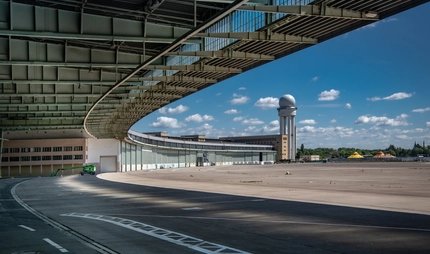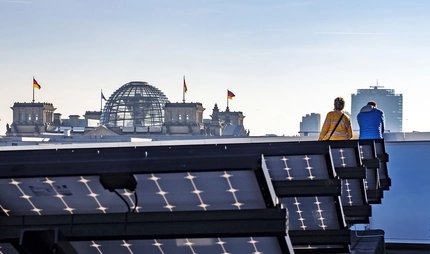
Haus der Statistik at Alexanderplatz
A place for community-led city planning
46.000 Quadratmeter Platz mitten in Berlin – Im Modellprojekt Haus der Statistik am Alexanderplatz können sich alle einbringen.
The Haus der Statistik at Alexanderplatz was empty and decaying for over a decade. But thanks to some ambitious pranksters turned free-thinking city planners, it's got a new lease on life.
From statisticians to Stasi to empty space
The Haus der Statistik near Alexanderplatz – an imposing structure of three interconnected rectangular high-rise buildings covering 46,000 square metres – was built in 1968 and served as headquarters to the GDR's national statistics office until reunification in 1990. After that, the Federal Statistics Office took over, even introducing an office for citizens to review files the Stasi kept on them during the time of the GDR surveillance state.

But by 2008, they'd moved out and the building remained vacant for years, a strange and slowly decaying sight in one of Berlin's most attractive locations. As Alexanderplatz developed around it, and Prenzlauer Berg to the north gentrified beyond all recognition, the Haus der Statistik lay dormant while plans for refurbishment, renovation, sale or demolition all failed to materialise. Plans to use it to house refugees in 2015 never came to fruition. It seemed like this huge building on some of Germany's most desirable real estate may just sit there, empty, forever. Either that, or it'd eventually be sold to developers who'd turn it into yet another luxury apartment building that normal Berliners could never afford.
An activism success story
The members of the 'Allianz bedrohter Berliner Atelierhäuser' (Alliance of Threatened Berlin Studio Houses, AbBA), an organisation advocating for affordable housing and space for artists, were frustrated that such a massive building was empty when so many people in the city needed housing and social spaces. So, they decided on an audacious act that was part prank, part protest, part criticism of the authorities. They hung an enormous official-looking banner on the building that said, "Here will be created for Berlin a space for art, culture and social activities" and held a press conference below the banner thanking the authorities for approving this development. While none of it was real, they actually did have a proper plan and proposal for the building. To their surprise and delight, the authorities took notice. Within weeks, they were speaking with the mayor of Mitte and consulting with designers on how to make their proposals into reality.
A community-oriented model project

The AbBa joined forces with other initiatives to form the ZUsammenKUNFT cooperative (a portmanteau of the German for 'together' and 'future') aiming to create a truly democratic plan for the Haus der Statistik. In 2017, the city of Berlin became owners of the building and made the activists who carried out the 2015 stunt into official partners of the project. Instead of the usual top-down project management, where authorities make decisions without input from normal citizens, this project is being handled in precisely the opposite way. Anyone with an opinion could have a say – and they were listened to.
The final concept for the project was revealed in 2019, a stunningly ambitious plan simply due to its down-to-earth character. The site will hold government buildings, housing, a kindergarten and multi-use spaces for artists, gatherings and much more. Housing for the elderly, refugees, small families and students will be prioritised. It will take years for full implementation as existing structures are either certified as safe for use, renovated or demolished and rebuilt. But the project is a truly ground-breaking achievement that, if successful, may change how urban spaces are developed both in Berlin and around the world.
Non-stop events and activities
Since getting the green light, the Haus der Statistik has held a wide range of exhibitions, performances, conferences, workshops, dance and theatre performances. It also introduced a number of new features to the site. These include:
- Sonnenbeet, a mobile garden that can move around the construction. It aims to educate people on sustainable foods, nutrition and urban green spaces
- Workshops for a zero-waste future to promote sharing, re-use, repairing, circular economy and upcycling
- An art trail through an 'urban sound park' with sound installations, interactive objects, sculptures and music machines by Ioana Vreme Moser and Erwin Stache
- There is a constant stream of new events and activities. The organisers – as they promised from the very start – remain open to any and all suggestions.
Sightseeing in the vicinity

Following a tour of the area, we can choose between numerous other sights. Alexanderplatz is an ideal starting point for exploring the old East Berlin. With the idyllic Nikolaiviertel, the oldest settlement area of Berlin is also in the immediate vicinity. Other sights such as the Hackesche Höfe, the lively Rosenthaler Platz or the Museum Island can be easily reached from here. And of course, the TV tower is right there.



